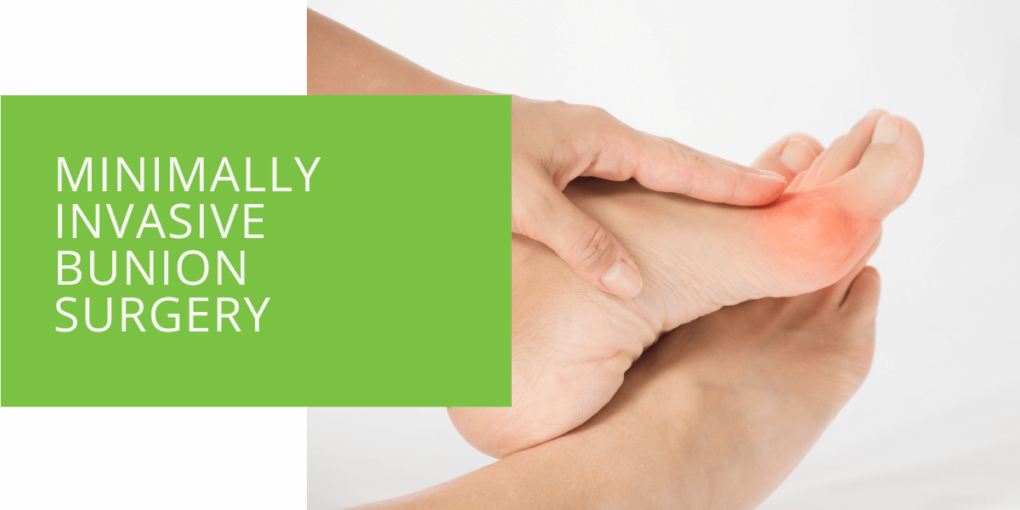Minimally Invasive Bunion Surgery
Do you dread putting on your favorite shoes because of the persistent pain and discomfort caused by a bunion on your big toe? You're not alone. Millions of people suffer from bunions, those unsightly and painful bumps that can make even the simplest activities a painful experience. But what if there was a way to eliminate the pain and discomfort of bunions without undergoing invasive surgery?
Fortunately, there is! Minimally Invasive Bunion Surgery is a groundbreaking technique that's transforming bunion treatment. Unlike traditional surgery, which involves large incisions and a lengthy recovery period, minimally invasive surgery uses small incisions and advanced technology to repair the bunion and correct the underlying bone deformity.
But what exactly is minimally invasive bunion surgery, and how does it work? In this comprehensive guide, we'll look at this cutting-edge approach to bunion correction, examining its benefits, surgical techniques, and what you need to know before opting for this procedure. Whether you're struggling with a painful bunion or simply want to learn more about bunion treatment options, this guide has everything you need to know about minimally invasive bunion surgery.
Key Takeaways
- Minimally invasive bunion surgery offers a revolutionary approach to correcting bunions with smaller incisions, less pain, and faster recovery compared to traditional surgery.
- Patients should consult with a foot and ankle surgeon to determine if they are a suitable candidate for minimally invasive bunion correction and ask essential questions about the procedure during the consultation.
- The availability of minimally invasive bunion surgery is increasing, making it accessible to individuals in various locations, providing relief from bunion pain and discomfort.
Exploring Minimally Invasive Bunion Correction
What Are Bunions?
Bunions, scientifically known as "hallux valgus," are a common foot problem characterized by the displacement of the big toe joint. This leads to the gradual development of a bony bump inside the foot. Bunions can cause pain and even affect your ability to wear regular shoes.
The Minimally Invasive Advantage
Minimally invasive bunion surgery, also known as minimally invasive bunionectomy, offers a groundbreaking alternative to traditional bunion surgery. The key difference lies in the surgical approach. Instead of making a large incision, surgeons utilize small incisions to assess the bunion deformity, minimizing tissue damage and postoperative pain.
Tiny Incisions, Big Benefits
One of the primary benefits of minimally invasive surgery is the size of the incisions. Traditional bunion surgery often requires more extensive incisions, resulting in larger scars and longer recovery times. In contrast, minimally invasive surgery patients can walk with smaller, barely noticeable scars and typically experience less pain during recovery.
The Surgical Technique
Minimally invasive bunion correction involves making small incisions around the bunion and performing precise osteotomies (bone cuts) to realign the big toe joint. Surgeons can manipulate the soft tissues and bone with specialized instruments, correcting the bunion deformity without needing larger, open procedures.
Faster Recovery
One of the standout advantages of minimally invasive bunion surgery is the significantly reduced recovery time. Patients often experience less postoperative pain and can return to normal activities faster than with traditional surgery. This is especially beneficial for those with severe bunions who want to get back on their feet quickly.
Why Minimally Invasive?
The benefits of minimally invasive bunion correction go beyond just smaller incisions and faster recovery. This approach minimizes the risk of complications, such as stiffness or arthritis in the big toe joint, which can be more common with traditional surgery.

The Procedure Unveiled
Types of Bunions
Before undergoing any surgery, it's essential to understand the specific type of bunion you have. Bunions can vary in size and severity, and the surgical approach may differ accordingly. Your foot and ankle surgeon will evaluate your condition and recommend the most appropriate treatment.
When Surgery Becomes Essential
Not all bunions require surgical intervention. However, if your bunion pain persists despite conservative treatments like wearing comfortable shoes, using padding, or taking pain relievers, it may be time to consider surgical bunion correction.
Locations Throughout
One of the great advantages of minimally invasive bunion surgery is its increasing availability. Many foot and ankle surgeons offer this advanced procedure. Whether in a bustling city or a quiet town, you'll likely find a qualified surgeon near you who can perform minimally invasive bunion correction.
Questions to Ask Your Podiatrist
Before the Procedure
Before scheduling your minimally invasive bunion surgery, it's crucial to understand the procedure and what to expect clearly. Here are some questions you should ask your podiatrist:
- What type of bunion do I have, and how severe is it?
- Is minimally invasive surgery the right choice for my condition?
- What are the potential risks and complications associated with the surgery?
- What is the expected recovery time, and what can I do to facilitate it?
- Will I need anesthesia for the procedure, and if so, what type will be used?
During Consultation
During your consultation with the foot and ankle surgeon, be sure to discuss any concerns or questions you may have. This is your opportunity to gain confidence in your decision and ensure you are well-prepared for the procedure.
Post-Surgery Concerns
After your minimally invasive bunion correction, following your surgeon's post-op instructions is essential. You may experience some discomfort, swelling, or stiffness, which are often temporary. Communicate any concerns with your surgeon, and they can guide you through the recovery process.
Conclusion
Our podiatrists have witnessed the transformative benefits of minimally invasive bunion surgery for countless patients. Our experienced foot and ankle surgeons are dedicated to providing the best possible care to ensure your comfort and speedy recovery. Don't let bunion pain hold you back any longer; take the first step toward relief and schedule an appointment with us today!
Minimally invasive bunion surgery offers a revolutionary approach to bunion correction, with smaller incisions, less pain, and faster recovery. It's a choice that can significantly improve your quality of life, allowing you to walk comfortably in your favorite shoes once again.
FAQ
Is Minimally Invasive Bunion Surgery Worth It?
Minimally invasive bunion surgery is often considered worth it due to its benefits, including smaller incisions, less pain, and faster recovery compared to traditional surgery. However, the decision should be based on an individual's condition and consultation with a foot and ankle surgeon.
How Long Does It Take to Recover from Minimally Invasive Bunion Surgery?
Recovery time can vary depending on the severity of the bunion and the individual's overall health. Patients can often return to normal activities faster than traditional surgery, typically within a few weeks to a few months.
Who Is a Candidate for Minimally Invasive Bunion Surgery?
Candidates for minimally invasive bunion surgery should consult a foot and ankle surgeon to determine eligibility. Generally, individuals with bunions that cause persistent pain and discomfort, despite conservative treatments, may be suitable candidates.
Is Minimally Invasive Bunion Surgery Effective?
Minimally invasive bunion surgery has proven effective in correcting bunions, realigning the big toe joint, and reducing pain. Its success depends on factors like the surgeon's skill, the patient's commitment to post-operative care, and the severity of the bunion. Consulting with a foot and ankle surgeon is crucial for assessing its effectiveness in individual cases.

